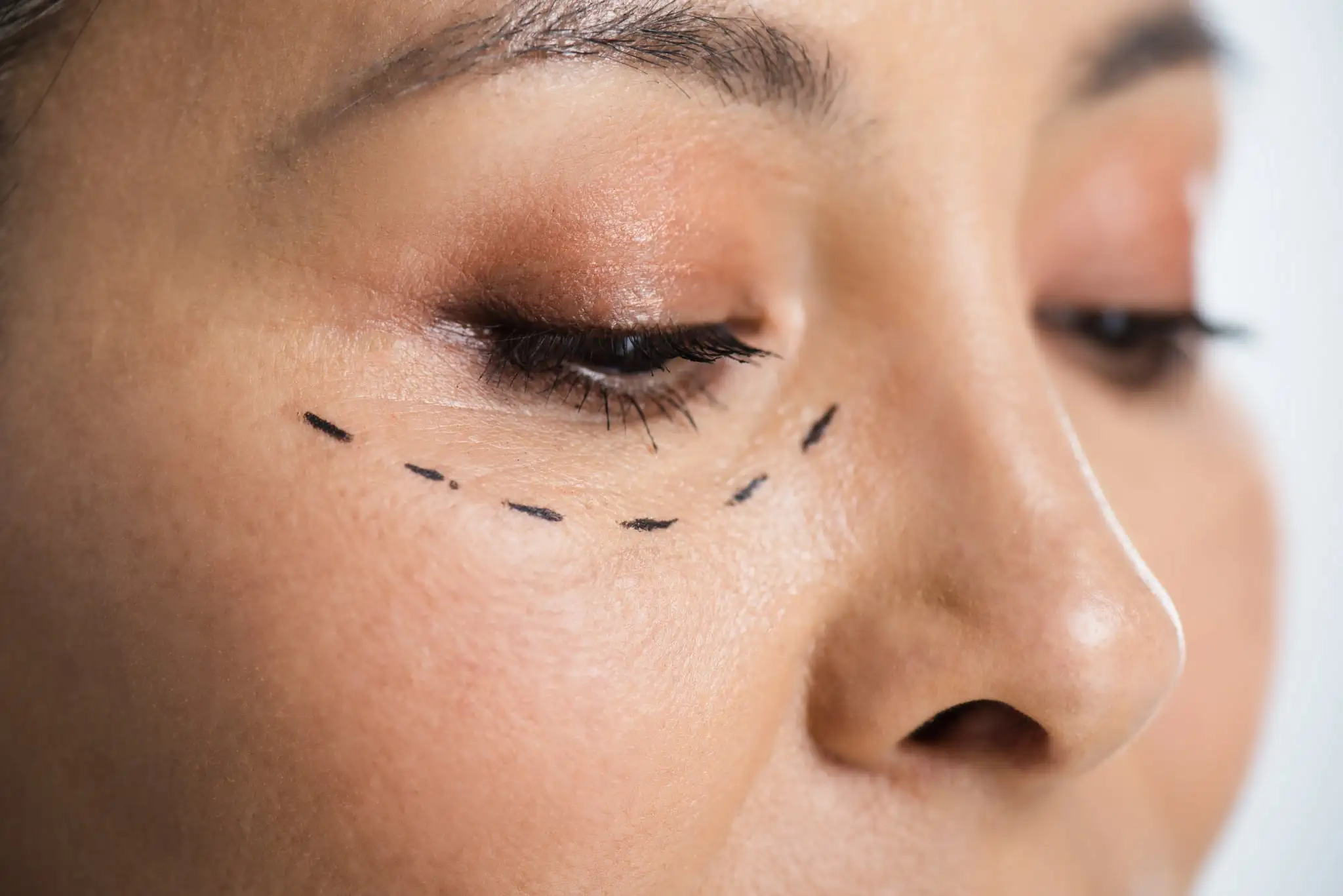Droopy lids are common and they don’t all mean the same thing. Sometimes it’s extra eyelid skin (often called dermatochalasis), other times the lid margin sits too low because the lifting muscle is weak (true ptosis).
Both can change how you look and how well you see, from a “tired” appearance to reduced upper-field vision and brow strain. The signs often overlap, which is why self-diagnosing can be tricky. This guide breaks down the differences clearly and walks you through the fixes.
What Is Blepharoplasty and What Problems Does It Fix?
Blepharoplasty, often called an “eye lift,” is a cosmetic surgical procedure focused on removing what’s around the eye. Its primary goal is to eliminate excess skin and fatty tissue that create a heavy, aged appearance. The outcome is a more open, refreshed, and youthful contour.
There are several types and techniques of blepharoplasty designed to suit different needs, from upper and lower procedures to more advanced methods like transconjunctival or fat repositioning. Understanding these variations helps determine which approach will achieve the most natural and balanced result.
What Is Ptosis Repair and When Is It Needed?
Ptosis is a medical condition where the entire upper eyelid margin droops down over the pupil. This is not about extra skin, but a weakness in the muscle that lifts the eyelid (the levator muscle).
Ptosis repair is a functional procedure designed to correct this muscle weakness. This is often needed when the drooping begins to block your vision, causes you to constantly raise your eyebrows, or creates a noticeable asymmetry between your two eyes.
Ptosis Repair vs Blepharoplasty: What Are the Main Differences?
The core difference lies in what each procedure corrects. Ptosis repair tightens the eyelid’s lifting muscle to fix a drooping lid margin, while blepharoplasty removes excess skin and fat causing hooding or bags.
Diagnosis also differs significantly. Ptosis requires precise measurements of lid height and muscle function, whereas blepharoplasty focuses on assessing skin redundancy and fatty protrusion.
Ultimately, ptosis repair aims to restore proper lid position and symmetry, while blepharoplasty creates a smoother, more refreshed eyelid contour.
Quick Comparison Table
Here’s a quick comparison table between ptosis repair and blepharoplasty:
| Feature | Ptosis Repair | Blepharoplasty |
| Main Purpose | Lifts a drooping eyelid caused by weak muscles | Removes excess skin or fat from the eyelids |
| Cause Treated | Muscle weakness (levator muscle) | Skin laxity or fat protrusion |
| Effect on Vision | Improves vision by raising eyelid height | Can improve vision if excess skin blocks sight |
| Incision Site | Hidden in the natural eyelid crease | In the eyelid crease (upper) or inside lid (lower) |
| Results | Corrects lid position and symmetry | Smooths, refreshes, and rejuvenates the eye area |
| Recovery Time | About 1–2 weeks | About 1–2 weeks |
| Best For | True droopy eyelids (ptosis) | Hooded lids, puffiness, or eye bags |
Can You Combine Ptosis Repair with Eyelid Surgery?
Absolutely. In fact, for many patients, combining the two procedures is the ideal approach to achieve a completely natural and balanced result. It is very common to have both a droopy eyelid (ptosis) and excess skin (dermatochalasis).
During a combined surgery, the surgeon will first perform the ptosis repair to correctly position the eyelid. Then, with the lid at its proper height, they can precisely tailor and remove the exact amount of excess skin via a blepharoplasty. The benefit is a single recovery period that addresses both the functional and aesthetic concerns simultaneously.
How To Choose Between Ptosis Repair and Blepharoplasty?
Figuring out which path is right for you starts with identifying your main concern. Here’s a simple guide:
- If your eyelid itself sits low over your pupil, especially if it affects your vision, you likely need ptosis repair.
- If you have a fold of skin resting on your eyelashes or noticeable under-eye bags, your solution is probably an eyelid surgery.
- If you have both issues or if a low brow is also a factor, then a combined procedure, potentially with a brow lift, will give you the best result.
The only way to know for sure is with a professional consultation. Your surgeon will perform precise measurements and take photos to confirm the best path forward for your unique anatomy.
Frequently Asked Questions (FAQs)
Ptosis is the drooping of the upper eyelid caused by weakness or stretching of the levator muscle. Blepharochalasis, on the other hand, is recurrent inflammation that leads to thinning and excess skin on the eyelids, often resembling dermatochalasis.
Yes. When both drooping (ptosis) and excess skin are present, surgeons often perform ptosis repair and blepharoplasty together. This combination lifts the eyelid to the correct height and removes redundant skin for optimal functional and aesthetic results.
The best approach depends on the severity and cause. The most common and effective procedure is levator advancement or resection, which tightens the muscle that lifts the eyelid. In severe cases or congenital ptosis, a frontalis sling may be used to connect the eyelid to the forehead muscle for improved elevation.
Temporary swelling, bruising, or uneven healing can make eyelids look asymmetrical or “off” during recovery. This usually resolves within a few weeks as tissues settle. Persistent irregularities are rare and typically related to swelling patterns or pre-existing asymmetry rather than surgical error.
Generally, no. Ptosis repair focuses on tightening or reattaching the levator muscle to lift the eyelid, not removing skin. However, if excess skin is also present, a small amount may be removed during a combined blepharoplasty.
Stitches are usually removed 5–7 days after surgery, depending on healing and the type of suture used. In some cases, dissolvable stitches are placed and naturally absorb within 1–2 weeks.
Find Your Path to Brighter Eyes
Understanding these differences is helpful, but only a consultation with an expert can determine your optimal path. This personalized assessment ensures your treatment plan is tailored specifically to your needs, giving you complete confidence in your decision.






